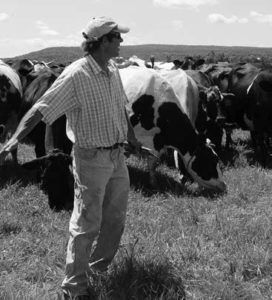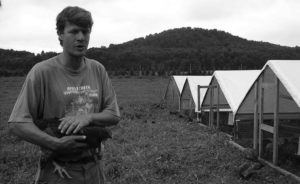Celebrating the Vitality of Grazing Farms with the Vermont Grass Farmers Association
The Vermont Grass Farmers Association is a farmer-driven organization dedicated to furthering the use of managed grazing for livestock to create healthier soils, stronger local economies, and happier farmers. Today, the organization thrives with several hundred members, a high quality annual educational conference, and excellent relationships with state and regional partners.
History
Domesticated ruminant animals have been grazing for centuries. The difference between older methods of continual grazing and the current “rotational” or “management-intensive” (MIG) grazing systems were built upon the work of Andre Voisin, a French farmer and biochemist. Voisin observed that smaller, intensively-rotated pastures were able to sustain the animals longer, with higher quality grass by containing the animals in smaller paddocks and moving them through the paddocks quickly. The animals ate the grass more evenly, and gave the plants a very important rest period.
A few key farmers brought the idea to Vermont from New Zealand, where Voisin’s methods were widely adopted. By the early 1990’s, Vermont farmers, recognizing the need for more MIG technical information and assistance, began to organize themselves in support of managing grass like other farmers raise corn or soy to feed their animals. Some testified to the State Agriculture Committee about the loss of farms in Vermont, the evolution toward larger farms, and the opportunities offered by grazing to address many economic, social, and environmental problems.
At the University of Vermont, Dr. Bill Murphy became a major contributor to managed grazing in Vermont and nationally, based on his experience using Voisin’s techniques in South America. He wrote “Greener Pastures On Your Side of The Fence”, a MIG primer, founded the Pasture Management Outreach Program (PMOP) at the University of Vermont, researched MIG techniques, and widely distributed grazing educational materials.
Birth of an Organization

A farmer with his grazing cows in the background. Photo by Jennifer Colby
VGFA’s excitement and energy came—as it does today—from a group of committed, passionate farmers. Nearly 65 farmers attended the first meeting of the VGFA, held at a farm in Brookfield, VT in the summer of 1996. By that fall, funding proposals and grants were written, and the first of many grazing activities were being planned.
The VGFA, the UVM Center for Sustainable Agriculture’s Pasture Program, and the USDA Natural Resource Conservation Service (NRCS) Grazing Lands Conservation Initiative (GLCI) have each played a cooperative role to support grazing in Vermont. USDA-NRCS GLCI has provided funding, as well as linking the partnership to additional state and federal staff. VGFA served as the state GLCI Steering Committee provideed farmer-driven vision and direction,. The UVM Center provided day-to-day staff, on-farm technical assistance, conference coordination, research, and outreach materials.
Communication with regional and national comrades indicate that this farmer-directed arrangement in unique in the country.
Today’s VGFA
Originally, the work of the Vermont Pasture Network partners focused on the formation of farmer discussion groups, an annual conference, informational newsletters, and a calendar of events. Many of those efforts continue today and have expanded to include new approaches as the need arises.
• The 14th Annual VT Grazing & Livestock Conference hosted about 400 attendees and included one day of pre-conference intensive workshops. The conference committee, which works closely with Center staff on the educational content, has expanded to include present and former VGFA board members, VT Sheep & Goat Association and VT Beef Producers Association partners. In 2010, VGFA was delighted to host the Northeast Pasture Research Consortium’s annual meeting as part of the conference week’s events.
• Lively farmer-to-farmer interaction is facilitated by staff through on farm pasture walks, discussion groups and topical workshops through the spring, summer and fall, advertised through the monthly Pasture Calendar publication and through VGFA’s quarterly member newsletter The Solar Dollar.
• As the VT GLCI Steering Committee, VGFA participates in State Technical Committee work, bringing the voice of grazing farmers to state interpretations of federal natural resource policy.
• In 2008, VGFA established a mini grant program providing support to farm-level grazing innovators. The program has funded research on pasture forage species, composting trials, new animal shelters and more.
• Increasingly, VGFA is taking a more active leadership role to work closely with other organizations on issues of importance to grazing livestock farmers, such as water quality, raw milk issues, livestock slaughter and processing, dairy farmer education, and grazing research.
The Vermont Grass Farmers Association was born out of the need for farmers to ensure a leadership role in their own future success. As an organization there have been ups and downs, periods of intense energy, and significant challenges. With a strong Board, energetic Pasture staff, and the benefits of strong collaborative relationships with regional, state and federal partners, VGFA looks forward to a positive future.
For more information about the Vermont Grass Farmers Association and the UVM Center for Sustainable Agriculture’s Pasture Program, contact Jennifer Colby at (802) 656-0858, jcolby@uvm.edu.


